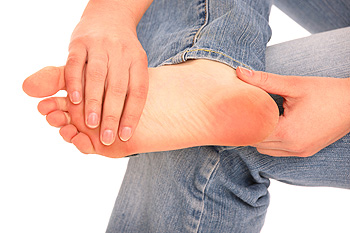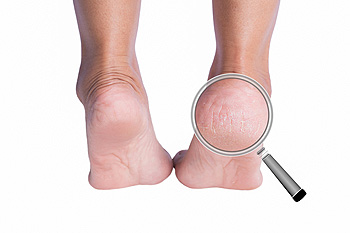Items filtered by date: January 2021
Location of Pain in Morton’s Neuroma
 There are several nerves in the foot, and the foot condition that is known as Morton’s neuroma can indicate a nerve enlargement. A common place for this to occur is between the third and fourth toes, and nerves that have become swollen in this area may be irritated. Common symptoms patients experience with Morton’s Neuroma can include cramping, a tingling sensation in the toes, or a stabbing pain in the overall foot. This painful ailment may occur from wearing shoes that are too tight, or it may develop from other foot conditions such as flat feet or high arches. Morton’s neuroma can be managed when treated by a podiatrist and it is strongly suggested that you consult with this type of doctor if you have foot pain.
There are several nerves in the foot, and the foot condition that is known as Morton’s neuroma can indicate a nerve enlargement. A common place for this to occur is between the third and fourth toes, and nerves that have become swollen in this area may be irritated. Common symptoms patients experience with Morton’s Neuroma can include cramping, a tingling sensation in the toes, or a stabbing pain in the overall foot. This painful ailment may occur from wearing shoes that are too tight, or it may develop from other foot conditions such as flat feet or high arches. Morton’s neuroma can be managed when treated by a podiatrist and it is strongly suggested that you consult with this type of doctor if you have foot pain.
Morton’s neuroma is a very uncomfortable condition to live with. If you think you have Morton’s neuroma, contact Dr. Odin De Los Reyes of Connecticut. Our doctor will attend to all of your foot care needs and answer any of your related questions.
Morton’s Neuroma
Morton's neuroma is a painful foot condition that commonly affects the areas between the second and third or third and fourth toe, although other areas of the foot are also susceptible. Morton’s neuroma is caused by an inflamed nerve in the foot that is being squeezed and aggravated by surrounding bones.
What Increases the Chances of Having Morton’s Neuroma?
- Ill-fitting high heels or shoes that add pressure to the toe or foot
- Jogging, running or any sport that involves constant impact to the foot
- Flat feet, bunions, and any other foot deformities
Morton’s neuroma is a very treatable condition. Orthotics and shoe inserts can often be used to alleviate the pain on the forefront of the feet. In more severe cases, corticosteroids can also be prescribed. In order to figure out the best treatment for your neuroma, it’s recommended to seek the care of a podiatrist who can diagnose your condition and provide different treatment options.
If you have any questions, please feel free to contact our offices located in Southbury and Farmington, CT . We offer the newest diagnostic and treatment technologies for all your foot care needs.
Arthritis Can Cause Pain in the Feet and Ankles
Types of Hammertoe Surgery
A hammertoe is a toe deformity that causes a toe to bend downward at the middle joint, creating a hammer-like or claw-like appearance. This can cause discomfort as the affected toes rubs against the shoes while walking. Hammertoes may become painful, stiff, and restricted in their range of motion if left untreated. While there are many conservative treatments for hammertoes, surgery may be needed for more severe cases. There are two main types of hammertoe surgery. In a fusion surgery, the surgeon cuts the ligaments, tendons, and the ends of the bones that form the middle joint of the hammertoe in order to straighten it. Pins and screws are then used to help the cut bones fuse together. In a joint resection surgery, the surgeon may also cut the ligaments and tendons, as well as the end of one bone, so that the toe can be straightened. To learn more about treatment for hammertoes, please consult with a podiatrist.
Hammertoe
Hammertoes can be a painful condition to live with. For more information, contact Dr. Odin De Los Reyes from Connecticut. Our doctor will answer any of your foot- and ankle-related questions.
Hammertoe is a foot deformity that affects the joints of the second, third, fourth, or fifth toes of your feet. It is a painful foot condition in which these toes curl and arch up, which can often lead to pain when wearing footwear.
Symptoms
- Pain in the affected toes
- Development of corns or calluses due to friction
- Inflammation
- Redness
- Contracture of the toes
Causes
Genetics – People who are genetically predisposed to hammertoe are often more susceptible
Arthritis – Because arthritis affects the joints in your toes, further deformities stemming from arthritis can occur
Trauma – Direct trauma to the toes could potentially lead to hammertoe
Ill-fitting shoes – Undue pressure on the front of the toes from ill-fitting shoes can potentially lead to the development of hammertoe
Treatment
Orthotics – Custom made inserts can be used to help relieve pressure placed on the toes and therefore relieve some of the pain associated with it
Medications – Oral medications such as anti-inflammatories or NSAIDs could be used to treat the pain and inflammation hammertoes causes. Injections of corticosteroids are also sometimes used
Surgery – In more severe cases where the hammertoes have become more rigid, foot surgery is a potential option
If you have any questions please contact our offices located in Southbury and Farmington, CT . We offer the newest diagnostic and treatment technologies for all your foot and ankle needs.
What Can Cause Cracked Heels?
 A foot condition that can cause pain, discomfort, and an unsightly appearance can be described as cracked heels. It can occur as a result of wearing shoes that have an open back, or possibly from specific medical conditions. These can include thyroid disorders, diabetes, or kidney concerns. Additionally, people who are overweight may experience cracked heels from the excess weight and pressure the heels endure. Mild relief may be found when the feet are soaked in warm water, followed by applying a good moisturizer on them. Research has indicated it may help to add a vitamin regime into your daily routine, in addition to drinking plenty of fresh water. If you have cracked heels, it is suggested that you confer with a podiatrist who can offer effective treatment options.
A foot condition that can cause pain, discomfort, and an unsightly appearance can be described as cracked heels. It can occur as a result of wearing shoes that have an open back, or possibly from specific medical conditions. These can include thyroid disorders, diabetes, or kidney concerns. Additionally, people who are overweight may experience cracked heels from the excess weight and pressure the heels endure. Mild relief may be found when the feet are soaked in warm water, followed by applying a good moisturizer on them. Research has indicated it may help to add a vitamin regime into your daily routine, in addition to drinking plenty of fresh water. If you have cracked heels, it is suggested that you confer with a podiatrist who can offer effective treatment options.
Cracked heels are unsightly and can cause further damage to your shoes and feet. If you have any concerns, contact Dr. Odin De Los Reyes from Connecticut. Our doctor can provide the care you need to keep you pain-free and on your feet.
Cracked Heels
Cracked heels appear unappealing and can make it harder for you walk around in sandals. Aside from looking unpleasant, cracked heels can also tear stockings, socks, and wear out your shoes. There are several methods to help restore a cracked heel and prevent further damage.
How Do You Get Them?
Dry skin is the number one culprit in creating cracked heels. Many athletes, walkers, joggers, and even swimmers suffer from cracked heels. Age and skin oil production play a role to getting cracked heels as well.
Promote Healing
Over the counter medicines can help, especially for those that need instant relief or who suffer from chronic dry feet.
Wear Socks – Wearing socks with medicated creams helps lock in moisture.
Moisturizers – Applying both day and night will help alleviate dryness which causes cracking.
Pumice Stones – These exfoliate and remove dead skin, which allows for smoother moisturizer application and better absorption into the skin.
Change in Diet
Eating healthy with a well-balanced diet will give the skin a fresh and radiant look. Your body responds to the kinds of food you ingest. Omega-3 fatty acids and zinc supplements can also revitalize skin tissue.
Most importantly, seek professional help if unsure how to proceed in treating cracked heels. A podiatrist will help you with any questions or information needed.
If you have any questions, please feel free to contact our offices located in Southbury and Farmington, CT . We offer the newest diagnostic and treatment technologies for all your foot care needs.
Why Foot Blisters Can Develop
 Parents who notice an area on their children’s foot that resembles a bubble are often aware that it may be a blister. A blister is the body’s natural healing response to skin that has become damaged for various reasons. These can include excess friction that can happen from wearing shoes that do not fit correctly, or from medical conditions such as psoriasis and eczema. Additionally, blisters may form as an allergic reaction to an insect bite or from a severe sunburn. It is beneficial to cover the blister with an elastic bandage, as this can protect the blister from draining prematurely. If your child has developed blisters on their feet, it is suggested that you consult with a podiatrist who can guide you toward proper treatment techniques.
Parents who notice an area on their children’s foot that resembles a bubble are often aware that it may be a blister. A blister is the body’s natural healing response to skin that has become damaged for various reasons. These can include excess friction that can happen from wearing shoes that do not fit correctly, or from medical conditions such as psoriasis and eczema. Additionally, blisters may form as an allergic reaction to an insect bite or from a severe sunburn. It is beneficial to cover the blister with an elastic bandage, as this can protect the blister from draining prematurely. If your child has developed blisters on their feet, it is suggested that you consult with a podiatrist who can guide you toward proper treatment techniques.
Blisters are prone to making everyday activities extremely uncomfortable. If your feet are hurting, contact Dr. Odin De Los Reyes of Connecticut. Our doctor can provide the care you need to keep you pain-free and on your feet.
Foot Blisters
Foot blisters develop as a result of constantly wearing tight or ill-fitting footwear. This happens due to the constant rubbing from the shoe, which can often lead to pain.
What Are Foot Blisters?
A foot blister is a small fluid-filled pocket that forms on the upper-most layer of the skin. Blisters are filled with clear fluid and can lead to blood drainage or pus if the area becomes infected.
How Do Blisters Form?
Blisters on the feet are often the result of constant friction of skin and material, usually by shoe rubbing. Walking in sandals, boots, or shoes that don’t fit properly for long periods of time can result in a blister. Having consistent foot moisture and humidity can easily lead to blister formation.
Prevention & Treatment
It is important to properly care for the affected area in order to prevent infection and ease the pain. Do not lance the blister and use a Band-Aid to provide pain relief. Also, be sure to keep your feet dry and wear proper fitting shoes. If you see blood or pus in a blister, seek assistance from a podiatrist.
If you have any questions, please feel free to contact our offices located in Southbury and Farmington, CT . We offer the newest diagnostic and treatment technologies for all your foot care needs.


